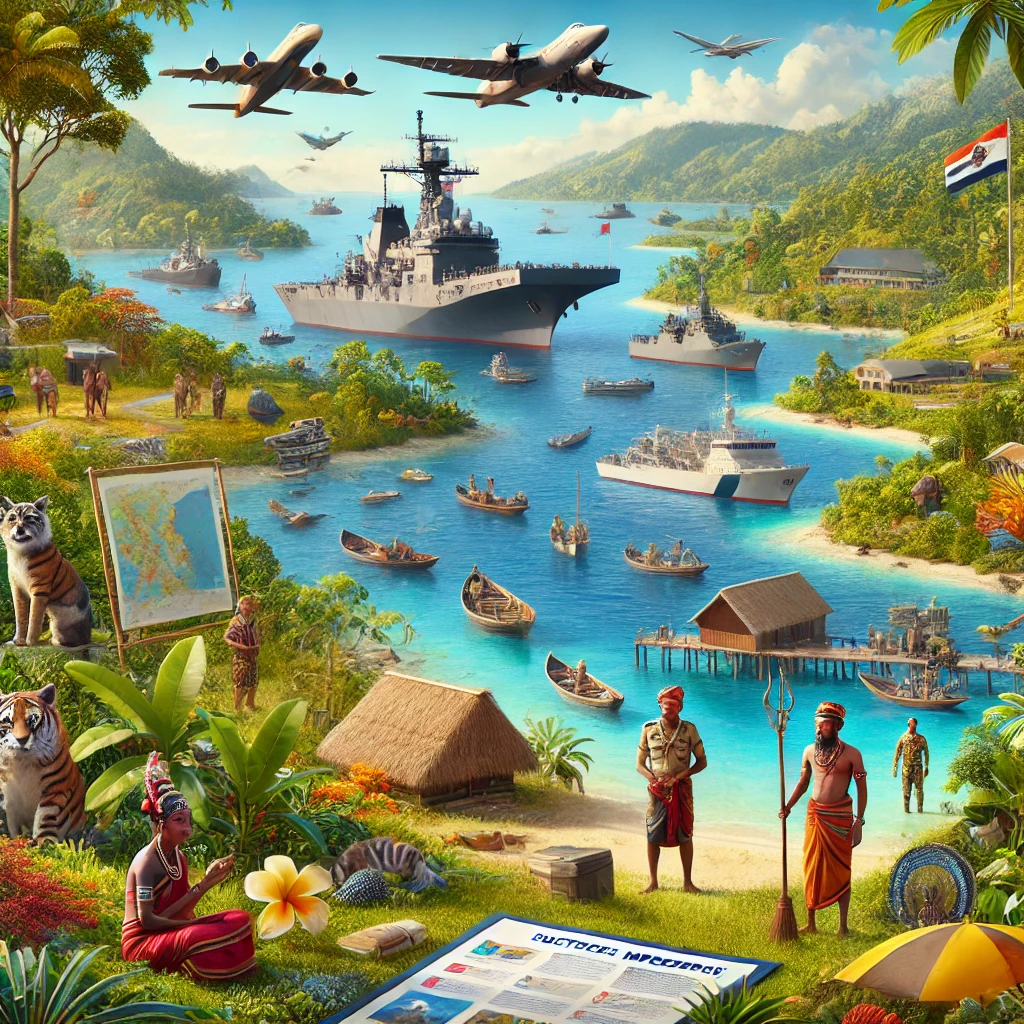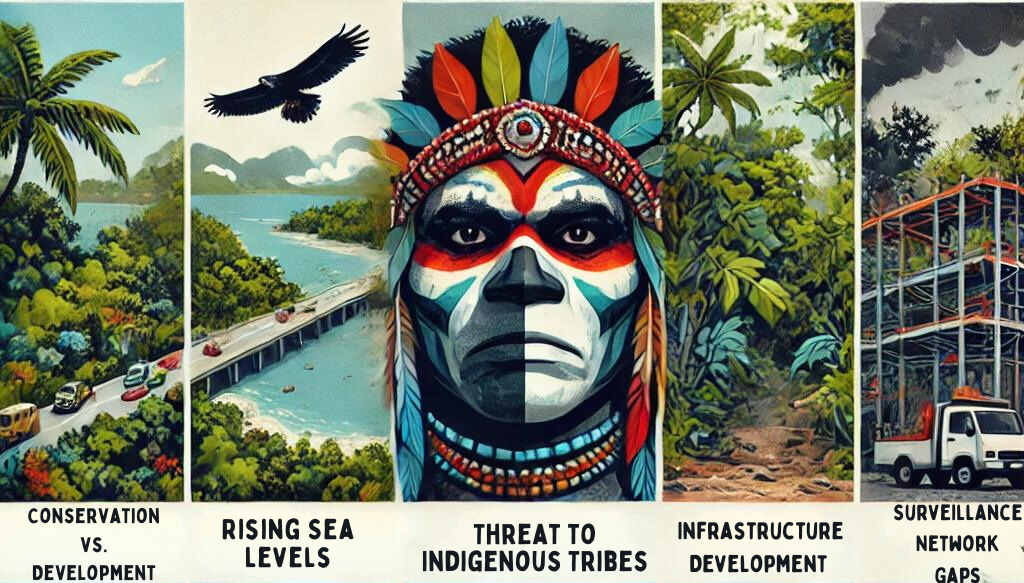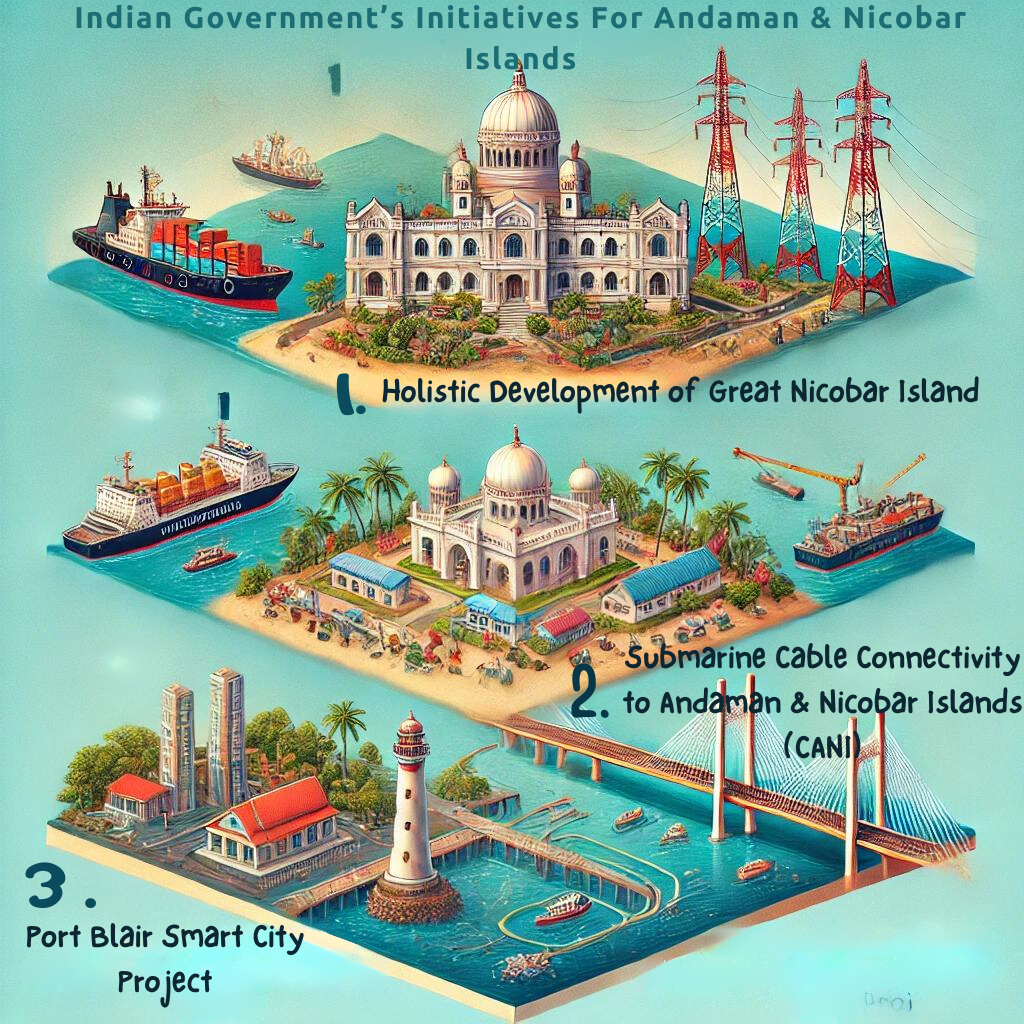The Andaman and Nicobar Islands hold significant strategic value for India’s maritime security and economic growth. Located in the Indian Ocean, these islands provide India with a crucial forward presence, enabling the monitoring of key maritime routes and naval activities. However, the sustainable development of these islands must balance strategic needs with environmental and social concerns, especially the well-being of indigenous tribes.
Origin of the Article
This editorial is based on “Making Andaman and Nicobar a maritime bastion is long overdue. Environmental concerns must be addressed” published in The Indian Express on 26/06/2024. The article discusses the strategic and economic potential of the Andaman & Nicobar Islands while emphasizing the need for sustainable development.
Relevancy for UPSC Students
For UPSC aspirants, understanding the strategic importance of the Andaman and Nicobar Islands is crucial. The topic is relevant to various GS papers, including government policies, environmental concerns, and issues related to indigenous tribes. Knowledge of this topic can aid in writing well-rounded answers in both Prelims and Mains examinations.

Why in News
The strategic importance of the Andaman and Nicobar Islands for India’s maritime security and economic development has recently come under the spotlight due to ongoing debates over the “Holistic Development of Great Nicobar Island” project. This topic is crucial for UPSC aspirants as it integrates key elements of GS Paper 2 and GS Paper 3, such as government policies, environmental issues, and sustainable development. Previous UPSC questions have frequently explored the region’s geography, coral reefs, and indigenous tribes, making this a significant area of study.
Core Body Structural Framework
Significance of Andaman and Nicobar Islands for India
The Andaman and Nicobar Islands hold immense strategic and economic importance for India. However, the development initiatives must ensure the preservation of the islands’ unique ecological and cultural heritage. A balanced approach is essential to protecting the natural environment and indigenous communities while advancing strategic and economic interests.
Guardian of the East
The Andaman and Nicobar Islands are positioned about 1,300 km southeast of the Indian mainland, making them crucial for India’s presence in the Bay of Bengal and Andaman Sea. This strategic location allows India to monitor and control key maritime chokepoints, particularly the Malacca Strait, enhancing its maritime domain awareness.
Projection of Naval Power
Serving as India’s first line of defense against eastern threats, the Andaman and Nicobar Islands are vital for projecting naval power into the eastern Indian Ocean and western Pacific. This is particularly significant given China’s growing naval presence in the region, such as at Sri Lanka’s Hambantota Port.
Economic Zone Extension
The Andaman and Nicobar Islands extend India’s Exclusive Economic Zone (EEZ) and continental shelf significantly, as per UNCLOS. This extension grants India access to vast marine resources, including undersea minerals, thereby enhancing its economic prospects.
Home to Indigenous Tribes
The islands are home to indigenous tribes like the Shompen, whose unique cultures and lifestyles are integral to the region’s identity. Preserving these cultures is crucial, as they have inhabited the islands for millennia and contribute significantly to its cultural richness.
Tri-Service Command
The Andaman and Nicobar Command (ANC), established in 2001, is India’s only tri-service theater command. It serves as a model for integrated military operations and holds strategic importance for future conflicts in the region, ensuring coordinated defense efforts.
Tourism Paradise
The pristine beaches, coral reefs, and unique wildlife of the Andaman and Nicobar Islands present immense potential for eco-tourism. Promoting eco-tourism can generate revenue, create jobs, and boost the local economy while preserving the natural environment.
Potential Hub for Maritime Trade
The development of Galathea Bay as a transshipment port on Great Nicobar Island could transform the region into a significant hub for international maritime trade. This development could rival major ports like Singapore, boosting economic activities and connectivity.
Major Challenges Related to Andaman and Nicobar Islands
The development of the Andaman and Nicobar Islands faces several challenges, necessitating sustainable and inclusive growth strategies. Addressing these challenges is essential for balanced development while safeguarding the region’s unique environment and communities.

Environmental Conservation vs. Development
Balancing strategic and economic development with environmental protection is a significant challenge. The unique ecosystems and biodiversity, such as leatherback turtle nesting sites in Galathea Bay, must be preserved while pursuing development projects.
Threats to Indigenous Tribes
Preserving the culture and rights of indigenous tribes like the Jarawas, Onges, and Sentinelese is complex. Development often conflicts with laws protecting these tribes, such as the Andaman and Nicobar Islands (Protection of Aboriginal Tribes) Regulation of 1956.
Infrastructure Development Hurdles
The island’s remote location, difficult terrain, and frequent seismic activity pose significant challenges to infrastructure development. Issues include sourcing materials, finding skilled labor, and ensuring infrastructure resilience against natural disasters.
Climate Change and Rising Sea Levels
As low-lying islands, the Andaman and Nicobar Islands are particularly vulnerable to climate change impacts, especially rising sea levels. This threatens both infrastructure and indigenous communities, necessitating long-term adaptive strategies.
Surveillance Network Gaps
Despite the strategic location, there are significant gaps in the surveillance network. The vast maritime expanse requires a sophisticated network of radar stations, UAVs, and maritime patrol aircraft, which is currently inadequate, leaving vulnerabilities in monitoring key chokepoints like the Six Degree Channel.
Major Indian Government’s Initiatives Related to Andaman and Nicobar Islands
The Indian government has taken several initiatives to promote holistic and sustainable development in the Andaman and Nicobar Islands. These initiatives aim to enhance infrastructure, connectivity, and economic potential while ensuring environmental conservation and cultural preservation.
Holistic Development of Great Nicobar Island
A comprehensive development project aims to improve infrastructure, boost economic potential, and enhance the quality of life on Great Nicobar Island. This project addresses various aspects of development while considering environmental and social impacts.
Submarine Cable Connectivity to Andaman & Nicobar Islands (CANI)
The initiative to enhance digital connectivity and communication infrastructure between the islands and the mainland aims to integrate the region better with the rest of India. Improved connectivity will facilitate economic activities and access to services.
Port Blair Smart City Project
The development of Port Blair into a smart city focuses on improving urban infrastructure and services. This project aims to enhance the quality of life for residents and visitors, making the city more livable and sustainable.

Strategies to Ensure Balanced Development in the Andaman and Nicobar Islands
Proposed strategies for balanced development in the Andaman and Nicobar Islands emphasize sustainable growth while preserving the environment and indigenous cultures. These strategies aim to integrate traditional knowledge with modern science and foster innovation.
Indigenous Knowledge Integration Center
Establishing a center combining traditional knowledge with modern science can lead to breakthroughs in fields like herbal medicine, sustainable forestry, and climate-resilient agriculture. This approach also preserves and celebrates indigenous cultures.
Maritime Startup Incubator
Creating an incubator for startups focusing on maritime technologies, ocean conservation, and sustainable island development can attract talent and investment. This fosters innovation in areas like marine robotics and sustainable fishing methods.
Diplomatic and Cultural Exchange Archipelago
Designating certain islands for international diplomatic and cultural exchanges can create unique opportunities for regional cooperation. An “island-hopping” summit format can combine high-level meetings with immersive cultural experiences.
Blockchain-Based Resource Management
Implementing a blockchain system for managing resources can ensure transparent and sustainable allocation. This system can manage fishing quotas, land use, and other resources efficiently, providing a model for other island nations.
Autonomous Maritime Defense Network
Developing a network of autonomous vehicles for defense and surveillance can enhance security without a large human footprint. This AI-driven system can serve as a model for advanced maritime defense strategies.
Tribal Heritage Guardians
Launching initiatives to protect tribal heritage and promote eco-tourism can create economic opportunities while preserving culture. Cultural Sanctuary Zones and Buffer Zones can minimize contact and generate income, supported by a Tribal Heritage Fund.
Circular Economy for Waste Management
Implementing a circular economy approach to waste management can turn waste into resources. This involves composting, upcycling, and bioconversion technologies, contributing to a sustainable and efficient waste management system.
Sustainable Gastronomy Initiative
Promoting a sustainable “ocean-to-table” food approach can enhance tourism and support local livelihoods. This initiative encourages sustainable food practices, benefiting both the environment and the local economy.
Underwater Research and Innovation Hub
Transforming the islands into a marine science and technology center can attract international collaboration. Establishing underwater research stations can pioneer sustainable aquaculture and blue biotechnology, positioning India as a leader in ocean sciences.
Renewable Energy Testbed
Utilizing the islands’ geography for renewable energy technology experiments can achieve energy self-sufficiency. Experimenting with tidal energy, offshore wind farms, and marine solar panels can also export clean energy to the mainland and neighboring countries.
Eco-Tourism Space Launch Site
Developing a commercial space launch facility that also serves as an ecotourism destination can attract tourists and scientists. The facility can offer satellite launches, space science workshops, and natural beauty, combining technological advancement with eco-tourism.
PESTEL Analysis
| Political: The strategic importance of the Andaman and Nicobar Islands is evident in India’s defense and maritime policies. The tri-service Andaman and Nicobar Command (ANC) enhances India’s military presence in the eastern Indian Ocean, which is crucial for countering regional threats, notably from China. Economic: Development projects like the Galathea Bay port and eco-tourism initiatives aim to transform the islands into a major economic hub, boosting maritime trade and tourism. However, these projects must balance economic growth, environmental sustainability, and local livelihoods. Social: The indigenous tribes such as the Shompen and Sentinelese hold significant cultural value. Development efforts must safeguard their heritage, integrating traditional knowledge into sustainable practices to protect their way of life. Technological: Enhancements like submarine cable connectivity and smart city projects in Port Blair aim to modernize infrastructure. Initiatives like a maritime startup incubator and autonomous defense networks showcase the integration of advanced technology for improved living standards and security. Environmental: The islands’ rich biodiversity faces threats from infrastructure projects. Preservation of ecosystems, such as leatherback turtle nesting sites, is essential. Sustainable development strategies include circular economy practices and renewable energy testbeds to minimize ecological impact. Legal: Regulatory frameworks must ensure that development projects comply with environmental and cultural preservation laws. Policies should promote transparent and efficient resource management, incorporating innovative solutions like blockchain technology for accountability. |
Conclusion
In conclusion, the Andaman and Nicobar Islands stand as a vital asset in India’s maritime security and economic landscape. However, their development must harmonize with environmental preservation and the protection of indigenous cultures. UPSC aspirants should recognize the delicate balance between strategic interests and sustainable development, understanding that true progress respects both nature and heritage.
| UPSC Civil Services Examination, Previous Year Questions (PYQs) Mains Q. Discuss the significance of the Indian Ocean region for India and explain the challenges faced by India in securing its maritime boundaries in this region. (GS-II, 2022) Q. Evaluate the potential economic benefits and environmental risks associated with the ‘Holistic Development of Great Nicobar Island’ project. Should India prioritize economic development over environmental conservation in this region? |

